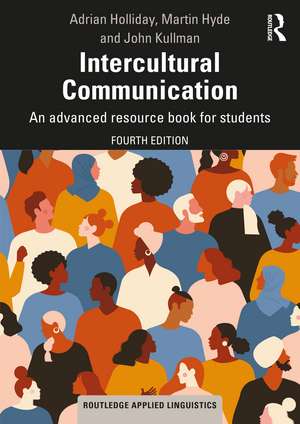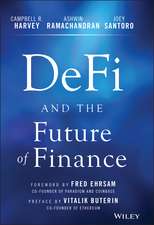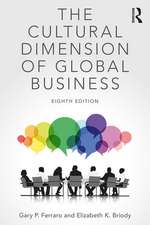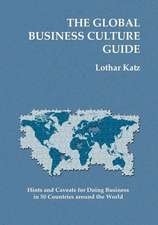Intercultural Communication: An advanced resource book for students: Routledge Applied Linguistics
Autor Adrian Hollidayen Limba Engleză Paperback – 30 apr 2021
The fourth edition of this popular textbook has been updated to feature:
- new readings by Kwame Antony Appiah, Yoshitaka Miike, Edward Ademolu and Siobhan Warrington, Helena Liu, Michael Zirulnik and Mark Orbe, which reflect the most recent developments in the field;
- refreshed and expanded examples and tasks including new material on an Asia-centric approach to intercultural communication, selfies as a global discourse, the impact on intercultural communication of English as a lingua franca in multinational organisations, and representations of Africa in charity media campaigns;
- extended discussions of topics including intercultural training, voluntourism, challenging essentialism in business contexts, and intersectional approaches to identity;
- revised further reading suggestions.
Written by experienced teachers and researchers in the field, this fourth edition ofIntercultural Communicationis an essential textbook for advanced students studying this topic.
| Toate formatele și edițiile | Preț | Express |
|---|---|---|
| Paperback (1) | 282.48 lei 3-5 săpt. | +27.03 lei 5-11 zile |
| Taylor & Francis – 30 apr 2021 | 282.48 lei 3-5 săpt. | +27.03 lei 5-11 zile |
| Hardback (1) | 770.45 lei 6-8 săpt. | |
| Taylor & Francis – 30 apr 2021 | 770.45 lei 6-8 săpt. |
Preț: 282.48 lei
Nou
54.06€ • 56.23$ • 44.63£
Carte disponibilă
Livrare economică 24 martie-07 aprilie
Livrare express 08-14 martie pentru 37.02 lei
Specificații
ISBN-10: 0367482460
Pagini: 344
Ilustrații: 17 Tables, black and white; 14 Line drawings, black and white; 14 Illustrations, black and white
Dimensiuni: 174 x 246 x 25 mm
Greutate: 0.57 kg
Ediția:4 ed
Editura: Taylor & Francis
Colecția Routledge
Seria Routledge Applied Linguistics
Locul publicării:Oxford, United Kingdom
Public țintă
Postgraduate and Undergraduate AdvancedCuprins
THEME 1 IDENTITY
Unit A1.1 People like me
Unit A1.2 Artefacts of culture
Unit A1.3 Identity card
THEME 2 ADDRESSING THE OTHER
Unit A2.1 Communication is about not presuming
Unit A2.2 Stamping Identity on new language. Finding intercultural threads
Unit A2.3 Power and discourse
THEME 3 REPRESENTATION
Unit A3.1 Cultural refugee
Unit A3.2 Complex images
Unit A3.3 The paradoxes of institutional life
Unit A3.4 Disciplines for intercultural communication
SECTION B: EXTENSION
INTRODUCTION
Unit B0.1 Current and Previous Approaches to the Study of Intercultural Communication
B0.1.1 Martin & Nakayama, ‘Thinking dialectically about culture and communication’
B0.1.2 Miike, ‘Intercultural communication ethics: an Asiacentric perspective’
Unit B0.2 Essentialist and Non- Essentialist Approaches to ‘Culture’
B0.2.1 Holliday, The Struggle to Teach English as an International Language
B02.2 Långstedt, ‘Culture, an excuse? —A critical analysis of essentialist assumptions in cross-cultural management research and practice’
THEME 1 IDENTITY
Unit B.1.1 Questions of identity
B1.1.1 Appiah, The Ties that Bind: Rethinking Identity: Creed, Country, Colour, Class, Culture
B1.1.2 Giddens, Modernity and Self-Identity: Self and Society in the Late Modern Age
B1.1.3 Baumann, Contesting Culture
Unit B.1.2 Discourse and identity
B1.2.1 De Fina, ‘Group identity, narrative and self-representations’
B1.2.2 Gee, An Introduction to Discourse Analysis: Theory and Method
Unit B.1.3 Cosmopolitanism and identity
B1.3.1 Sobré-Denton & Bardhan, Cultivating Cosmopolitanism for Intercultural Communication
B1.3.2 Skovgaard- Smith & Poulfelt, ‘Imagining ‘non-nationality’: Cosmopolitanism as a source of identity and belonging’
Unit B.1.4 Discourse, identity and intercultural communication
B1.4.1 Scollon & Scollon, ‘Discourse and intercultural communication’
1.4.2 Roberts & Sarangi, ‘Theme-oriented discourse analysis of medical encounters’
Unit B1.5 Identity and language learning
B1.5.1 Pellegrino, Study Abroad and Second Language Use
B1.5.2 Pavlenko and Lantolf, ‘Second language learning as participation and the (re) construction of selves’
THEME 2 OTHERING
Unit B2.1 Othering – Spotlight on Africa
B2.1.1 Edgar & Sedgwick, Key Concepts in Cultural Theory
B2.1.2 Ademolu & Warrington, ‘Who Gets to Talk About NGO Images of Global Poverty?’
B2.1.3 Ademolu, ‘Seeing and Being the Visualised 'Other': Humanitarian Representations and Hybridity in African Diaspora Identities’
Unit B2.2 Othering of Outsiders in China and Self- Othering of ‘Chinese Australians’
B 2.2.1 Liu,Y. & Self, ‘Laowai as a discourse of Othering: unnoticed stereotyping of American expatriates in Mainland China’
B 2.2.2 Liu, H., ‘Beneath the white gaze: Strategic Self-Orientalism among Chinese Australians’.
Unit B2.3 Power and the Other in Intercultural Communication: Voluntourism
B2.3.1 Jakubiak, ‘"English Is Out There—You Have to Get with the Program": Linguistic Instrumentalism, Global Citizenship Education, and English-Language Voluntourism’.
B2.3.2 McAllum & Zahra, ‘The positive impact of othering in voluntourism: The role of the relational other in becoming another self’
Unit B2.4 The English Language and The Other
B2.4.1 Neeley, ‘Language Matters: Status Loss and Achieved Status Distinctions in Global Organizations’
B 2.4.2 Shuck, ‘Racialising the non-native English speaker’ 146
B2.4.3 Lee Su Kim, A Nyonya in Texas: Insights of a Straits Chinese Woman in the Lone Star State
THEME 3 REPRESENTATION
Unit B3.1 Representation and Self- Representation: Intersectionality and Co-Cultural Theory
B3.1.1 Lucke, Engstrand, & Zander ‘Desilencing Complexities: Addressing Categorization in Cross-Cultural Management with Intersectionality and Relationality’.
B3.1.2 Zirulnik & Orbe ‘Black Female Pilot Communicative Experiences Applications and Extensions of Co-Cultural Theory’
Unit B3.2 Self - representation online
B3.2.1 Veum & Moland ‘The selfie as a global discourse’
B3.2.2 Brooks & Pitts, ‘Communication and identity management in a globally connected classroom: An online international and intercultural learning experience’.
Unit B3.3 Representation in the media – The case of ‘asylum seekers’
B3.3.1: van Dijk, ‘New(s) racism: a discourse analytical approach’
B3.3.2: O'Sullivan, Hartley, Saunders, Montgomery & Fiske, Key Concepts in Communication and Cultural Studies
B3.3.3: Moloney G, ‘Social representations and the politically satirical cartoon:the construction and reproduction of the refugee and asylum-seeker identity’
Unit B3.4 Cultural constructs in intercultural training
B3.4.1 Triandis, Individualism and Collectivism Extract 1
B3.4.2 Triandis, Individualism and Collectivism Extract 2
B3.4.3: Shepherd, ‘Cultural awareness workshops: limitations and practical consequences’
Unit B3.5 Challenging constructs in intercultural training and education
B3.5.1 Holmes, ‘The cultural stuff around how to talk to people’: immigrants’ intercultural communication during a pre-employment work-placement’
B3.5.2 Holliday, ‘Difference and awareness in cultural travel: negotiating blocks and threads’
SECTION C: EXPLORATION
THEME 1 IDENTITY
Unit C1.1 The story of the self
Unit C1.2 Becoming the self by defining the Other
Unit C1.3 Undoing cultural fundamentalism
Unit C1.4 Investigating discourse and power
Unit C1.5 Locality and transcendence of locality: Factors in identity
formation
THEME 2 OTHERING
Unit C2.1 Othering
Unit C2.2 ‘As you speak, therefore you are’
Unit C2.3 The ‘located’ self
Unit C2.4 Integrating the Other
Unit C2.5 ‘Are you what you are supposed to be?’
THEME 3 REPRESENTATION
Unit C3.1 ‘You are, therefore I am’
Unit C3.2 ‘Schemas’: fixed or flexible?
Unit C3.3 ‘What’s underneath?’
Unit C3.4 ‘Manufacturing the self’
Unit C3.5 ‘Minimal clues lead to big conclusions’
Notă biografică
Martin Hyde is an international education consultant.
John Kullman is a sessional lecturer in applied linguistics at Canterbury Christ Church University, UK.
Recenzii
Dr Ako Inuzuka, University of Pennsylvania, USA "Recent events have dramatically changed our ways of living and interacting, highlighting our need and desire to connect with others and flourish together. This latest edition of Intercultural Communication could not be more welcome or relevant, providing precisely the conceptual, practical and research tools needed. The authors identify a set of practical guidelines or ‘disciplines’, for participating in intercultural experiences, and offer detailed deconstructions of a wide range of examples and scenarios which feel fresh and authentic. The foregrounding of investigation and mini-research projects as a means of applying the disciplines in practice, is a real strength. The book cleverly mirrors the very process it is seeking to illuminate; it is an invitation to engage, investigate and act with understanding, critical awareness and ethical responsibility. Holliday, Kullman and Hyde's offering is comprehensive and incisive; a must read for advanced students and emerging researchers of intercultural communication."
Dr Michelle Kohler, University of South Australia
Descriere
Intercultural Communication provides a critical introduction to the dynamic arena of communication across different cultural and social strata. Throughout this book, topics are revisited, extended, interwoven and deconstructed, with the reader's understanding strengthened by tasks and follow-up questions.
The fourth edition of this popular textbook has been updated to feature:
- new readings by Kwame Antony Appiah, Yoshitaka Miike, Edward Ademolu and Siobhan Warrington, Helena Liu, Michael Zirulnik and Mark Orbe, which reflect the most recent developments in the field;
- refreshed and expanded examples and tasks including new material on an Asia-centric approach to intercultural communication, selfies as a global discourse, the impact on intercultural communication of English as a lingua franca in multinational organisations, and representations of Africa in charity media campaigns;
- extended discussions of topics including intercultural training, voluntourism, challenging essentialism in business contexts, and intersectional approaches to identity;
- revised further reading suggestions.
Written by experienced teachers and researchers in the field, this fourth edition of Intercultural Communication is an essential textbook for advanced students studying this topic.




























